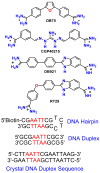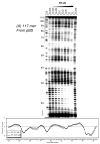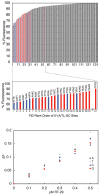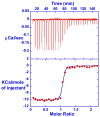Unusually strong binding to the DNA minor groove by a highly twisted benzimidazole diphenylether: induced fit and bound water
- PMID: 17506529
- PMCID: PMC2519038
- DOI: 10.1021/bi700288g
Unusually strong binding to the DNA minor groove by a highly twisted benzimidazole diphenylether: induced fit and bound water
Abstract
RT29 is a dicationic diamidine derivative that does not obey the classical "rules" for shape and functional group placement that are expected to result in strong binding and specific recognition of the DNA minor groove. The compound contains a benzimidazole diphenyl ether core that is flanked by the amidine cations. The diphenyl ether is highly twisted and gives the entire compound too much curvature to fit well to the shape of the minor groove. DNase I footprinting, fluorescence intercalator displacement studies, and circular dichroism spectra, however, indicate that the compound is an AT specific minor groove binding agent. Even more surprisingly, quantitative biosensor-surface plasmon resonance and isothermal titration calorimetric results indicate that the compound binds with exceptional strength to certain AT sequences in DNA with a large negative enthalpy of binding. Crystallographic results for the DNA complex of RT29 compared to calculated results for the free compound show that the compound undergoes significant conformational changes to enhance its minor groove interactions. In addition, a water molecule is incorporated directly into the complex to complete the compound-DNA interface, and it forms an essential link between the compound and base pair edges at the floor of the minor groove. The calculated DeltaCp value for complex formation is substantially less than the experimentally observed value, which supports the idea of water being an intrinsic part of the complex with a major contribution to the DeltaCp value. Both the induced fit conformational changes of the compound and the bound water are essential for strong binding to DNA by RT29.
Figures













References
-
- Tidwell RR, Boykin DW. Dicationic DNA minor-groove binders as antimicrobial agents. In: Demeunynck M, Bailly C, Wilson WD, editors. DNA and RNA Binders: From Small Molecules to Drugs. WILEY-VCH; Weinheim: 2003. pp. 414–460.
-
- Wilson WD, Nguyen B, Tanious FA, Mathis A, Hall JE, Stephens CE, Boykin DW. Dications that target the DNA minor groove: compound design and preparation, DNA interactions, cellular distribution and biological activity. Curr Med Chem Anti-Canc Agents. 2005;5:389–408. - PubMed
-
- Neidle S. DNA minor-groove recognition by small molecules. Nat Prod Rep. 2001:291–309. - PubMed
-
- Dervan PB, Edelson BS. Recognition of the DNA minor groove by pyrrole-imidazole polyamides. Curr Opin Struct Biol. 2003:284–299. - PubMed
Publication types
MeSH terms
Substances
Grants and funding
LinkOut - more resources
Full Text Sources

